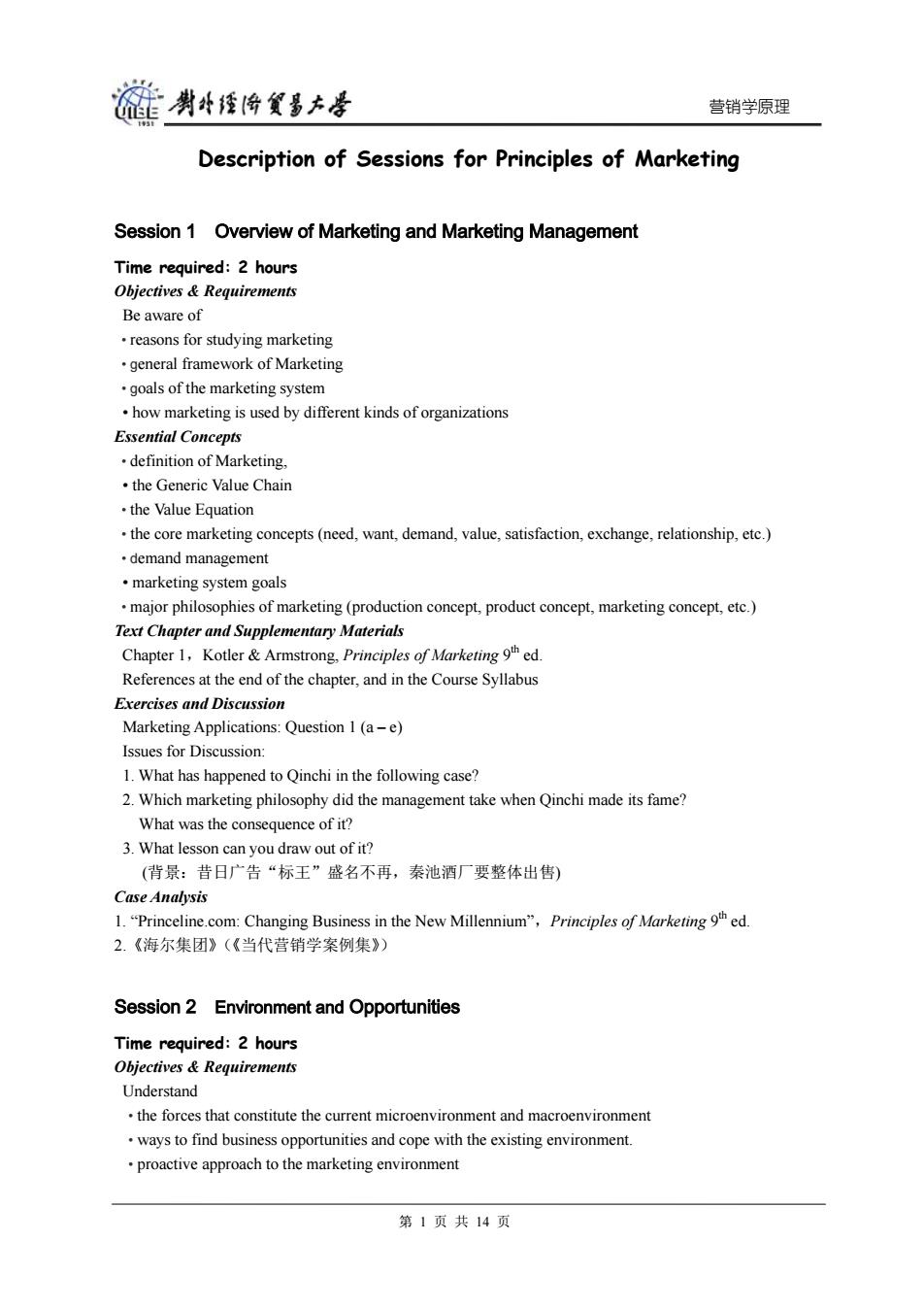
裢贵华经将贸墨去号 营销学原理 Description of Sessions for Principles of Marketing Session 1 Overview of Marketing and Marketing Management Time required:2 hours Objectives Requirements Be aware of reasons for studying marketing general framework of Marketing goals of the marketing system how marketing is used by different kinds of organizations Essential Concepts definition of Marketing, the Generic Value Chain ·the Value Equation the core marketing concepts(need,want,demand,value,satisfaction,exchange,relationship,etc.) ·demand management marketing system goals major philosophies of marketing(production concept,product concept,marketing concept,etc.) Text Chapter and Supplementary Materials Chapter 1,Kotler Armstrong,Principles of Marketing 9h ed References at the end of the chapter,and in the Course Syllabus Exercises and Discussion Marketing Applications:Question 1(a-e) Issues for Discussion: 1.What has happened to Qinchi in the following case? 2.Which marketing philosophy did the management take when Qinchi made its fame? What was the consequence of it? 3.What lesson can you draw out of it? (背景:昔日广告“标王”盛名不再,秦池酒厂要整体出售) Case Analysis 1."Princeline.com:Changing Business in the New Millennium",Principles of Marketing 9th ed. 2.《海尔集团》(《当代营销学案例集》) Session 2 Environment and Opportunities Time required:2 hours Objectives Requirements Understand the forces that constitute the current microenvironment and macroenvironment ways to find business opportunities and cope with the existing environment. proactive approach to the marketing environment 第1页共14页
营销学原理 Description of Sessions for Principles of Marketing Session 1 Overview of Marketing and Marketing Management Time required: 2 hours Objectives & Requirements Be aware of • reasons for studying marketing • general framework of Marketing • goals of the marketing system • how marketing is used by different kinds of organizations Essential Concepts • definition of Marketing, • the Generic Value Chain • the Value Equation • the core marketing concepts (need, want, demand, value, satisfaction, exchange, relationship, etc.) • demand management • marketing system goals • major philosophies of marketing (production concept, product concept, marketing concept, etc.) Text Chapter and Supplementary Materials Chapter 1,Kotler & Armstrong, Principles of Marketing 9th ed. References at the end of the chapter, and in the Course Syllabus Exercises and Discussion Marketing Applications: Question 1 (a – e) Issues for Discussion: 1. What has happened to Qinchi in the following case? 2. Which marketing philosophy did the management take when Qinchi made its fame? What was the consequence of it? 3. What lesson can you draw out of it? (背景:昔日广告“标王”盛名不再,秦池酒厂要整体出售) Case Analysis 1. “Princeline.com: Changing Business in the New Millennium”,Principles of Marketing 9th ed. 2.《海尔集团》(《当代营销学案例集》) Session 2 Environment and Opportunities Time required: 2 hours Objectives & Requirements Understand • the forces that constitute the current microenvironment and macroenvironment • ways to find business opportunities and cope with the existing environment. • proactive approach to the marketing environment 第 1 页 共 14 页

莲剥4将发多大号 营销学原理 Essential Concepts marketing environment forces of microenvironment (company,intermediaries,customer,markets,suppliers,competitors,publics) internal environment forces of macroenvironment (demographic Economic,natural,technological,political,cultural environment,etc.) access to environmental information environmental management perspective ways to respond to the marketing environment Text Chapter and Supplementary Materials Chapter 3,Kotler&Armstrong,Principles of Marketing hed References at the end of the chapter,and in the Course Syllabus Exercises and Discussion Marketing Applications:Question 2(a-c) Issues for Discussion: 1.What threats have Chinese textile manufacturers and traders have been faced with since China entered WTO? 2.Find a case story showing a particular company that has well turned the threats to opportunities,and state the factors to its success. Case Analysis: 《中国收获机械(集团)公司、英特尔公司》(《当代营销学案例集》) Session 3 Consumer Buying Behavior Time required:2 hours Objectives Requirements Be aware of the model of consumer behavior the external and internal factors influencing buyers how manufacturers try to bring their new products to the attention of early adopters Essential Concepts reference group ·opinion leader consumer buying roles types of buying decision behavior the buyer decision process ·adoption process Text Chapter and Supplementary Materials Chapter 5,Kotler&Armstrong,Principles of Marketing 9th ed. References at the end of the chapter,and in the Course Syllabus Exercises and Discussion 第2页共14页
营销学原理 Essential Concepts • marketing environment • forces of microenvironment (company, intermediaries, customer, markets, suppliers, competitors, publics) • internal environment • forces of macroenvironment (demographic Economic, natural, technological, political, cultural environment, etc.) • access to environmental information • environmental management perspective • ways to respond to the marketing environment Text Chapter and Supplementary Materials Chapter 3,Kotler & Armstrong, Principles of Marketing 9th ed. References at the end of the chapter, and in the Course Syllabus Exercises and Discussion Marketing Applications: Question 2 (a – c) Issues for Discussion: 1.What threats have Chinese textile manufacturers and traders have been faced with since China entered WTO? 2.Find a case story showing a particular company that has well turned the threats to opportunities, and state the factors to its success. Case Analysis: 《中国收获机械(集团)公司、英特尔公司》(《当代营销学案例集》) Session 3 Consumer Buying Behavior Time required: 2 hours Objectives & Requirements Be aware of • the model of consumer behavior • the external and internal factors influencing buyers • how manufacturers try to bring their new products to the attention of early adopters Essential Concepts • reference group • opinion leader • consumer buying roles • types of buying decision behavior • the buyer decision process • adoption process Text Chapter and Supplementary Materials Chapter 5,Kotler & Armstrong, Principles of Marketing 9th ed. References at the end of the chapter, and in the Course Syllabus Exercises and Discussion 第 2 页 共 14 页
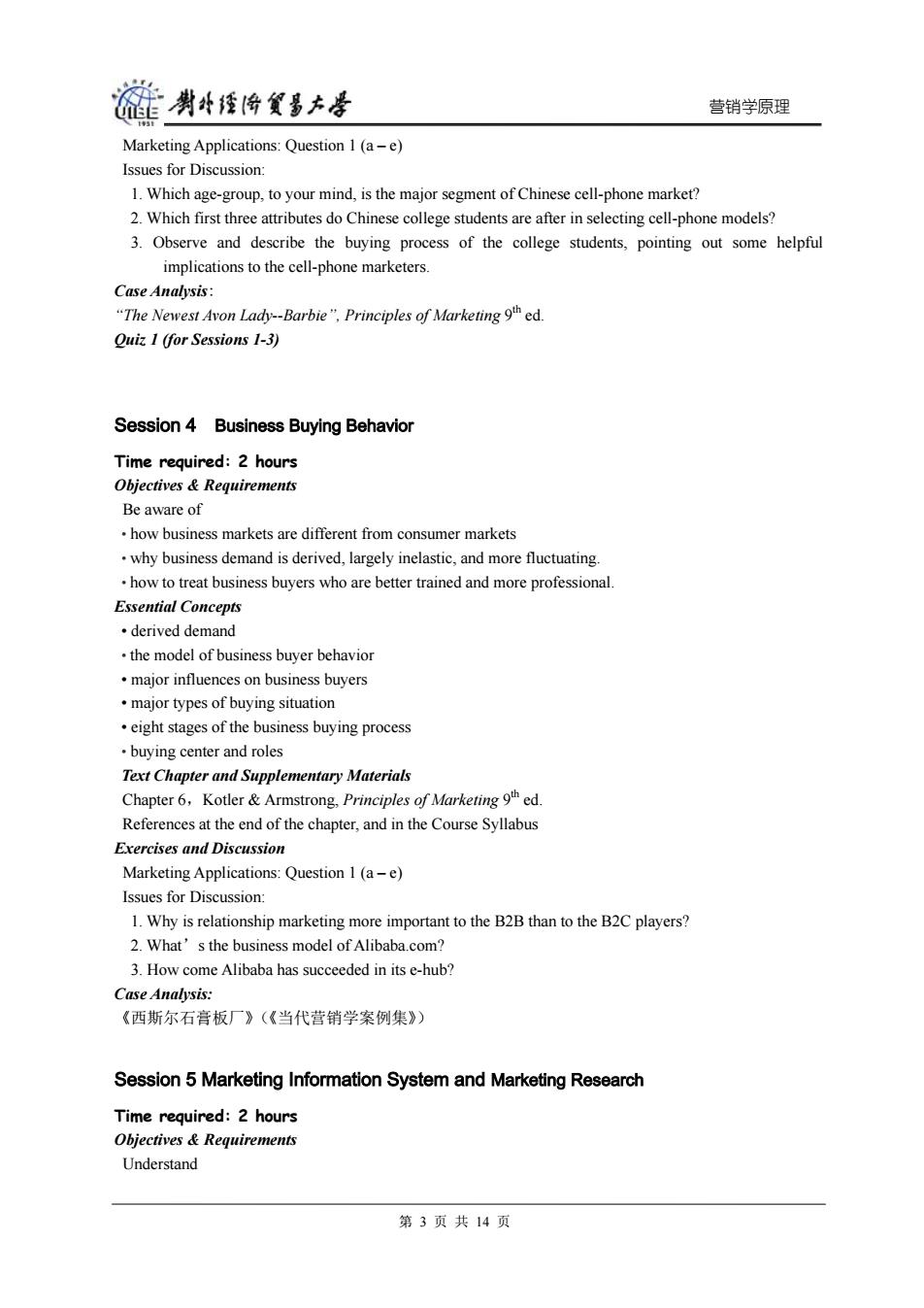
链男4经降贸多大是 营销学原理 Marketing Applications:Question 1(a-e) Issues for Discussion: 1.Which age-group,to your mind,is the major segment of Chinese cell-phone market? 2.Which first three attributes do Chinese college students are after in selecting cell-phone models? 3.Observe and describe the buying process of the college students,pointing out some helpful implications to the cell-phone marketers. Case Analysis: "The Newest Avon Lady--Barbie"Principles of Marketing 9h ed. Quiz I (for Sessions 1-3) Session 4 Business Buying Behavior Time required:2 hours Objectives Requirements Be aware of how business markets are different from consumer markets why business demand is derived,largely inelastic,and more fluctuating. how to treat business buyers who are better trained and more professional Essential Concepts ·derived demand the model of business buyer behavior major influences on business buyers major types of buying situation eight stages of the business buying process buying center and roles Text Chapter and Supplementary Materials Chapter 6,Kotler Armstrong,Principles of Marketing 9th ed. References at the end of the chapter,and in the Course Syllabus Exercises and Discussion Marketing Applications:Question 1(a-e) Issues for Discussion: 1.Why is relationship marketing more important to the B2B than to the B2C players? 2.What's the business model of Alibaba.com? 3.How come Alibaba has succeeded in its e-hub? Case Analysis: 《西斯尔石膏板厂》(《当代营销学案例集》) Session 5 Marketing Information System and Marketing Research Time reguired:2 hours Objectives Requirements Understand 第3页共14页
营销学原理 Marketing Applications: Question 1 (a – e) Issues for Discussion: 1. Which age-group, to your mind, is the major segment of Chinese cell-phone market? 2. Which first three attributes do Chinese college students are after in selecting cell-phone models? 3. Observe and describe the buying process of the college students, pointing out some helpful implications to the cell-phone marketers. Case Analysis: “The Newest Avon Lady--Barbie”, Principles of Marketing 9th ed. Quiz 1 (for Sessions 1-3) Session 4 Business Buying Behavior Time required: 2 hours Objectives & Requirements Be aware of • how business markets are different from consumer markets • why business demand is derived, largely inelastic, and more fluctuating. • how to treat business buyers who are better trained and more professional. Essential Concepts • derived demand • the model of business buyer behavior • major influences on business buyers • major types of buying situation • eight stages of the business buying process • buying center and roles Text Chapter and Supplementary Materials Chapter 6,Kotler & Armstrong, Principles of Marketing 9th ed. References at the end of the chapter, and in the Course Syllabus Exercises and Discussion Marketing Applications: Question 1 (a – e) Issues for Discussion: 1. Why is relationship marketing more important to the B2B than to the B2C players? 2. What’s the business model of Alibaba.com? 3. How come Alibaba has succeeded in its e-hub? Case Analysis: 《西斯尔石膏板厂》(《当代营销学案例集》) Session 5 Marketing Information System and Marketing Research Time required: 2 hours Objectives & Requirements Understand 第 3 页 共 14 页
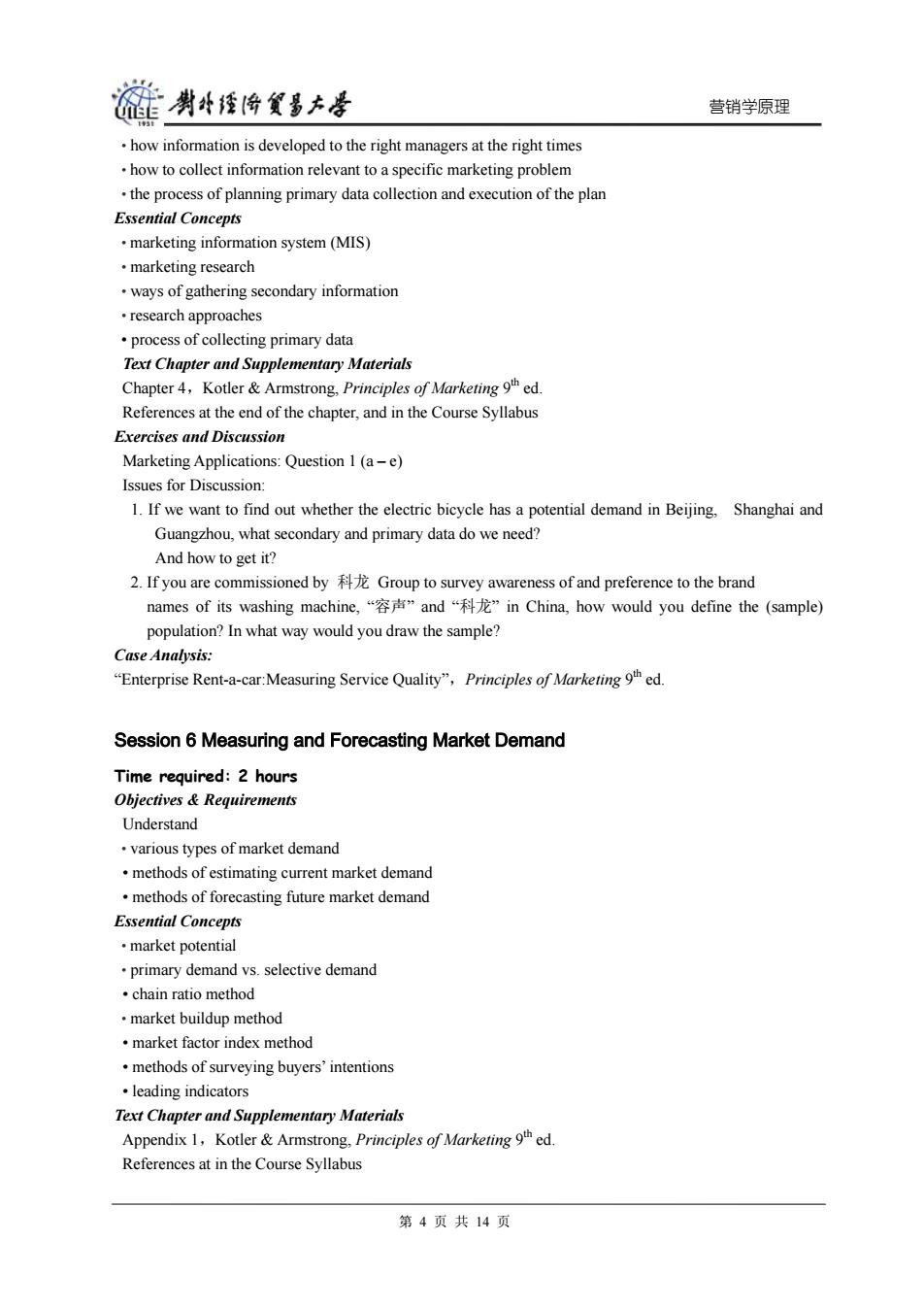
链喇哈餐多方孝 营销学原理 how information is developed to the right managers at the right times how to collect information relevant to a specific marketing problem the process of planning primary data collection and execution of the plan Essential Concepts marketing information system(MIS) ·narketing research ways of gathering secondary information research approaches process of collecting primary data Text Chapter and Supplementary Materials Chapter 4,Kotler Armstrong,Principles of Marketing h ed. References at the end of the chapter,and in the Course Syllabus Exercises and Discussion Marketing Applications:Question 1(a-e) Issues for Discussion: 1.If we want to find out whether the electric bicycle has a potential demand in Beijing,Shanghai and Guangzhou,what secondary and primary data do we need? And how to get it? 2.If you are commissioned byGroup to survey awareness of and preference to the brand names of its washing machine,“容声”and“科龙”in China,how would you define the(sample) population?In what way would you draw the sample? Case Analysis: "Enterprise Rent-a-car:Measuring Service Quality",Principles of Marketing 9h ed Session 6 Measuring and Forecasting Market Demand Time required:2 hours Objectives Requirements Understand various types of market demand methods of estimating current market demand methods of forecasting future market demand Essential Concepts ·market potential primary demand vs.selective demand ·chain ratio method market buildup method market factor index method methods of surveying buyers'intentions ·leading indicators Text Chapter and Supplementary Materials Appendix 1,Kotler&Armstrong,Principles of Marketing 9th ed. References at in the Course Syllabus 第4页共14页
营销学原理 • how information is developed to the right managers at the right times • how to collect information relevant to a specific marketing problem • the process of planning primary data collection and execution of the plan Essential Concepts • marketing information system (MIS) • marketing research • ways of gathering secondary information • research approaches • process of collecting primary data Text Chapter and Supplementary Materials Chapter 4,Kotler & Armstrong, Principles of Marketing 9th ed. References at the end of the chapter, and in the Course Syllabus Exercises and Discussion Marketing Applications: Question 1 (a – e) Issues for Discussion: 1. If we want to find out whether the electric bicycle has a potential demand in Beijing, Shanghai and Guangzhou, what secondary and primary data do we need? And how to get it? 2. If you are commissioned by 科龙 Group to survey awareness of and preference to the brand names of its washing machine, “容声” and “科龙” in China, how would you define the (sample) population? In what way would you draw the sample? Case Analysis: “Enterprise Rent-a-car:Measuring Service Quality”,Principles of Marketing 9th ed. Session 6 Measuring and Forecasting Market Demand Time required: 2 hours Objectives & Requirements Understand • various types of market demand • methods of estimating current market demand • methods of forecasting future market demand Essential Concepts • market potential • primary demand vs. selective demand • chain ratio method • market buildup method • market factor index method • methods of surveying buyers’ intentions • leading indicators Text Chapter and Supplementary Materials Appendix 1,Kotler & Armstrong, Principles of Marketing 9th ed. References at in the Course Syllabus 第 4 页 共 14 页
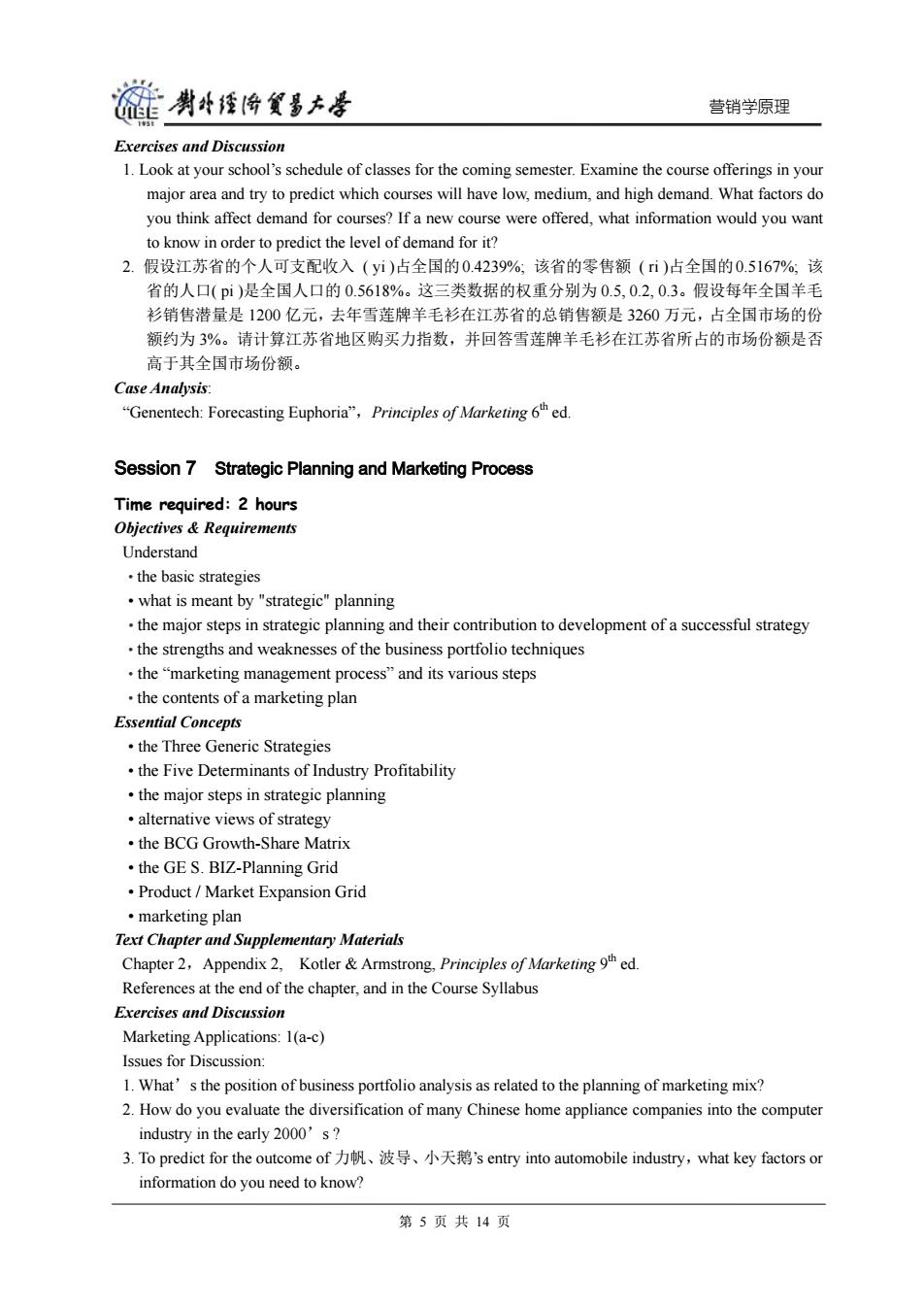
链喇4哈餐多方孝 营销学原理 Exercises and Discussion 1.Look at your school's schedule of classes for the coming semester.Examine the course offerings in your major area and try to predict which courses will have low,medium,and high demand.What factors do you think affect demand for courses?If a new course were offered,what information would you want to know in order to predict the level of demand for it? 2.假设江苏省的个人可支配收入(yi)占全国的0.4239%;该省的零售额(i)占全国的0.5167%,该 省的人口(p1)是全国人口的0.5618%。这三类数据的权重分别为0.5,0.2,0.3。假设每年全国羊毛 衫销售潜量是1200亿元,去年雪莲牌羊毛衫在江苏省的总销售额是3260万元,占全国市场的份 额约为3%。请计算江苏省地区购买力指数,并回答雪莲牌羊毛衫在江苏省所占的市场份额是否 高于其全国市场份额。 Case Analysis. "Genentech:Forecasting Euphoria",Principles of Marketing 6hed. Session 7 Strategic Planning and Marketing Process Time required:2 hours Objectives Requirements Understand the basic strategies what is meant by "strategic"planning the major steps in strategic planning and their contribution to development of a successful strategy the strengths and weaknesses of the business portfolio techniques ·the“marketing management process'”and its various steps the contents of a marketing plan Essential Concepts the Three Generic Strategies the Five Determinants of Industry Profitability the major steps in strategic planning alternative views of strategy the BCG Growth-Share Matrix the GE S.BIZ-Planning Grid Product Market Expansion Grid ·marketing plan Text Chapter and Supplementary Materials Chapter 2,Appendix 2,Kotler Armstrong,Principles of Marketing 9th ed. References at the end of the chapter,and in the Course Syllabus Exercises and Discussion Marketing Applications:1(a-c) Issues for Discussion: 1.What's the position of business portfolio analysis as related to the planning of marketing mix? 2.How do you evaluate the diversification of many Chinese home appliance companies into the computer industry in the early 2000's? 3.To predict for the outcome of力帆、波导、小天鹅's entry into automobile industry,what key factors or information do you need to know? 第5页共14页
营销学原理 Exercises and Discussion 1. Look at your school’s schedule of classes for the coming semester. Examine the course offerings in your major area and try to predict which courses will have low, medium, and high demand. What factors do you think affect demand for courses? If a new course were offered, what information would you want to know in order to predict the level of demand for it? 2. 假设江苏省的个人可支配收入 ( yi )占全国的0.4239%; 该省的零售额 ( ri )占全国的0.5167%; 该 省的人口( pi )是全国人口的 0.5618%。这三类数据的权重分别为 0.5, 0.2, 0.3。假设每年全国羊毛 衫销售潜量是 1200 亿元,去年雪莲牌羊毛衫在江苏省的总销售额是 3260 万元,占全国市场的份 额约为 3%。请计算江苏省地区购买力指数,并回答雪莲牌羊毛衫在江苏省所占的市场份额是否 高于其全国市场份额。 Case Analysis: “Genentech: Forecasting Euphoria”,Principles of Marketing 6th ed. Session 7 Strategic Planning and Marketing Process Time required: 2 hours Objectives & Requirements Understand • the basic strategies • what is meant by "strategic" planning • the major steps in strategic planning and their contribution to development of a successful strategy • the strengths and weaknesses of the business portfolio techniques • the “marketing management process” and its various steps • the contents of a marketing plan Essential Concepts • the Three Generic Strategies • the Five Determinants of Industry Profitability • the major steps in strategic planning • alternative views of strategy • the BCG Growth-Share Matrix • the GE S. BIZ-Planning Grid • Product / Market Expansion Grid • marketing plan Text Chapter and Supplementary Materials Chapter 2,Appendix 2, Kotler & Armstrong, Principles of Marketing 9th ed. References at the end of the chapter, and in the Course Syllabus Exercises and Discussion Marketing Applications: 1(a-c) Issues for Discussion: 1. What’s the position of business portfolio analysis as related to the planning of marketing mix? 2. How do you evaluate the diversification of many Chinese home appliance companies into the computer industry in the early 2000’s ? 3. To predict for the outcome of 力帆、波导、小天鹅’s entry into automobile industry,what key factors or information do you need to know? 第 5 页 共 14 页
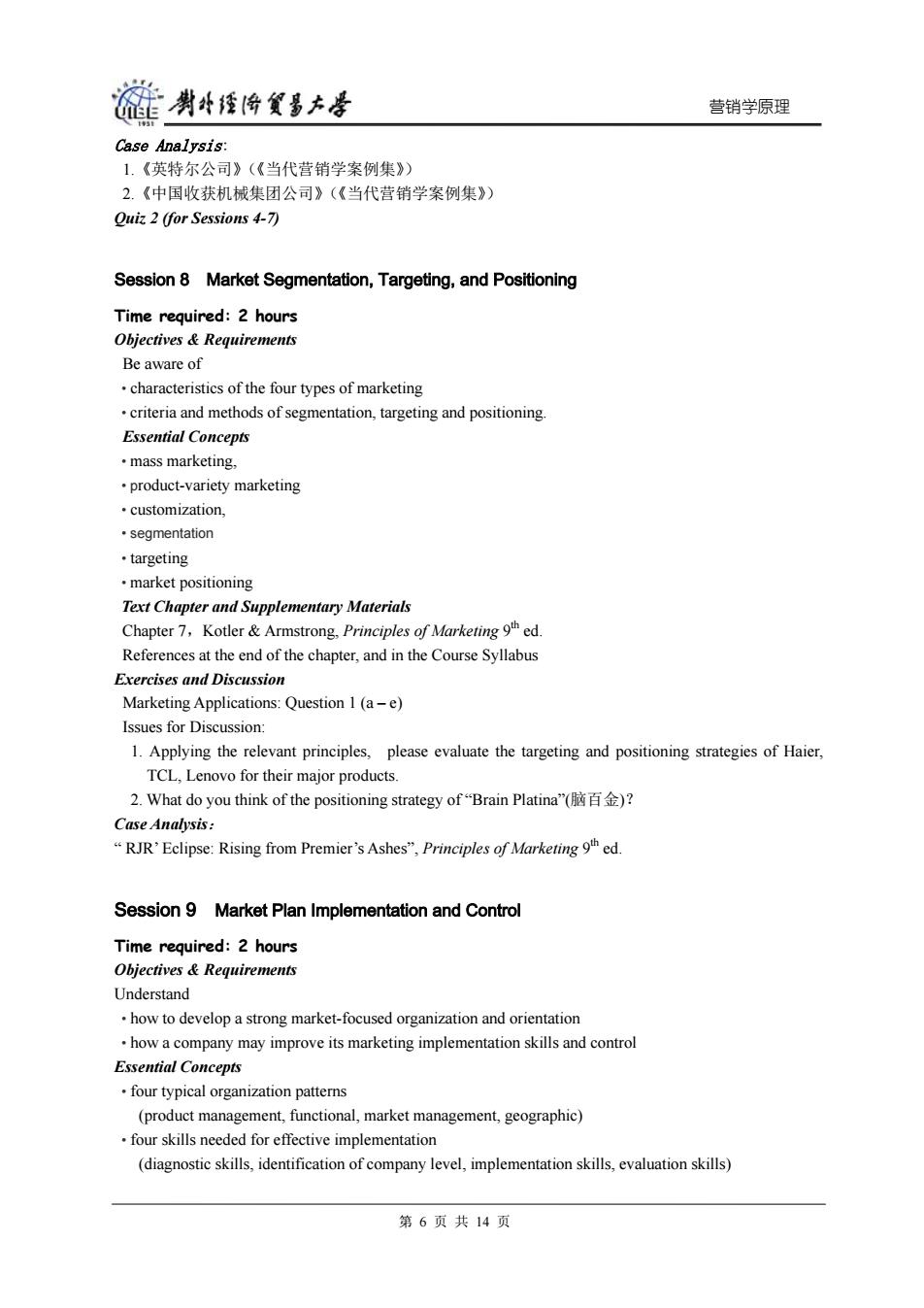
碰剥经悔贸墨大号 营销学原理 Case Analysis: 1.《英特尔公司》(《当代营销学案例集》) 2.《中国收获机械集团公司》(《当代营销学案例集》) Ouiz 2 (for Sessions 4-7) Session 8 Market Segmentation,Targeting,and Positioning Time required:2 hours Objectives Requirements Be aware of characteristics of the four types of marketing criteria and methods of segmentation,targeting and positioning. Essential Concepts ·mass marketing, product-variety marketing ·customization,. ·segmentation ·targeting ·market positioning Text Chapter and Supplementary Materials Chapter 7,Kotler Armstrong,Principles of Marketing 9th ed. References at the end of the chapter,and in the Course Syllabus Exercises and Discussion Marketing Applications:Question 1(a-e) Issues for Discussion: 1.Applying the relevant principles,please evaluate the targeting and positioning strategies of Haier, TCL,Lenovo for their major products. 2.What do you think of the positioning strategy of"Brain Platina'”(脑百金)? Case Analysis: "RJR'Eclipse:Rising from Premier's Ashes",Principles of Marketing 9ed Session 9 Market Plan Implementation and Control Time required:2 hours Objectives Requirements Understand how to develop a strong market-focused organization and orientation how a company may improve its marketing implementation skills and control Essential Concepts .four typical organization patterns (product management,functional,market management,geographic) four skills needed for effective implementation (diagnostic skills,identification of company level,implementation skills,evaluation skills) 第6页共14页
营销学原理 Case Analysis: 1.《英特尔公司》(《当代营销学案例集》) 2.《中国收获机械集团公司》(《当代营销学案例集》) Quiz 2 (for Sessions 4-7) Session 8 Market Segmentation, Targeting, and Positioning Time required: 2 hours Objectives & Requirements Be aware of • characteristics of the four types of marketing • criteria and methods of segmentation, targeting and positioning. Essential Concepts • mass marketing, • product-variety marketing • customization, • segmentation • targeting • market positioning Text Chapter and Supplementary Materials Chapter 7,Kotler & Armstrong, Principles of Marketing 9th ed. References at the end of the chapter, and in the Course Syllabus Exercises and Discussion Marketing Applications: Question 1 (a – e) Issues for Discussion: 1. Applying the relevant principles, please evaluate the targeting and positioning strategies of Haier, TCL, Lenovo for their major products. 2. What do you think of the positioning strategy of “Brain Platina”(脑百金)? Case Analysis: “ RJR’ Eclipse: Rising from Premier’s Ashes”, Principles of Marketing 9th ed. Session 9 Market Plan Implementation and Control Time required: 2 hours Objectives & Requirements Understand • how to develop a strong market-focused organization and orientation • how a company may improve its marketing implementation skills and control Essential Concepts • four typical organization patterns (product management, functional, market management, geographic) • four skills needed for effective implementation (diagnostic skills, identification of company level, implementation skills, evaluation skills) 第 6 页 共 14 页
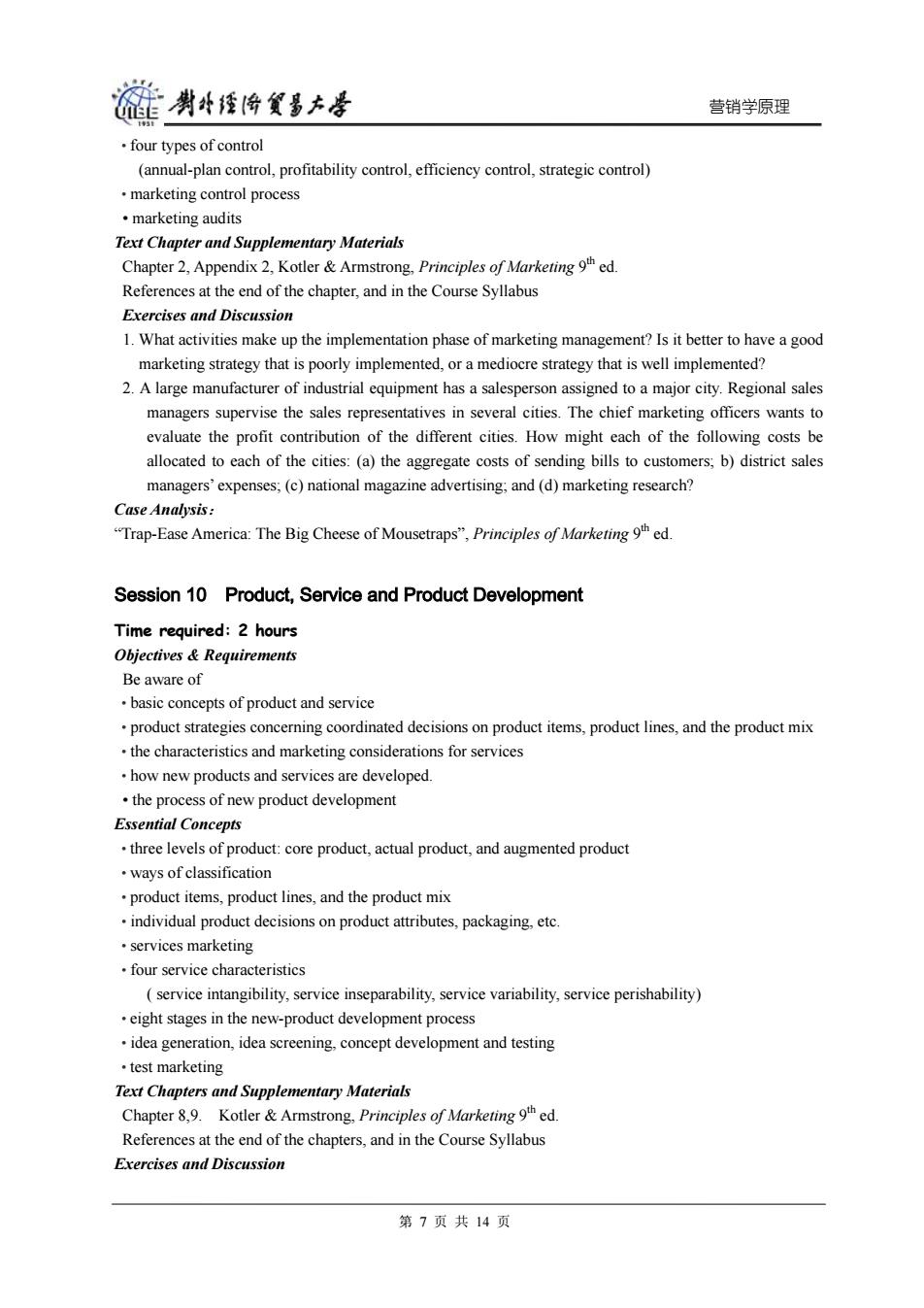
链男4经降贸多大是 营销学原理 ·four types of control (annual-plan control,profitability control,efficiency control,strategic control) marketing control process ·marketing audits Text Chapter and Supplementary Materials Chapter 2,Appendix 2,Kotler&Armstrong,Principles of Marketing 9th ed. References at the end of the chapter,and in the Course Syllabus Exercises and Discussion 1.What activities make up the implementation phase of marketing management?Is it better to have a good marketing strategy that is poorly implemented,or a mediocre strategy that is well implemented? 2.A large manufacturer of industrial equipment has a salesperson assigned to a major city.Regional sales managers supervise the sales representatives in several cities.The chief marketing officers wants to evaluate the profit contribution of the different cities.How might each of the following costs be allocated to each of the cities:(a)the aggregate costs of sending bills to customers;b)district sales managers'expenses;(c)national magazine advertising;and(d)marketing research? Case Analysis: "Trap-Ease America:The Big Cheese of Mousetraps",Principles of Marketing 9h ed. Session 10 Product,Service and Product Development Time required:2 hours Objectives Requirements Be aware of basic concepts of product and service product strategies concerning coordinated decisions on product items,product lines,and the product mix the characteristics and marketing considerations for services how new products and services are developed. the process of new product development Essential Concepts three levels of product:core product,actual product,and augmented product ways of classification product items,product lines,and the product mix individual product decisions on product attributes,packaging,etc. ·services marketing four service characteristics service intangibility,service inseparability,service variability,service perishability) eight stages in the new-product development process idea generation,idea screening,concept development and testing ·test marketing Text Chapters and Supplementary Materials Chapter 8,9.Kotler Armstrong,Principles of Marketing 9h ed. References at the end of the chapters,and in the Course Syllabus Exercises and Discussion 第7页共14页
营销学原理 • four types of control (annual-plan control, profitability control, efficiency control, strategic control) • marketing control process • marketing audits Text Chapter and Supplementary Materials Chapter 2, Appendix 2, Kotler & Armstrong, Principles of Marketing 9th ed. References at the end of the chapter, and in the Course Syllabus Exercises and Discussion 1. What activities make up the implementation phase of marketing management? Is it better to have a good marketing strategy that is poorly implemented, or a mediocre strategy that is well implemented? 2. A large manufacturer of industrial equipment has a salesperson assigned to a major city. Regional sales managers supervise the sales representatives in several cities. The chief marketing officers wants to evaluate the profit contribution of the different cities. How might each of the following costs be allocated to each of the cities: (a) the aggregate costs of sending bills to customers; b) district sales managers’ expenses; (c) national magazine advertising; and (d) marketing research? Case Analysis: “Trap-Ease America: The Big Cheese of Mousetraps”, Principles of Marketing 9th ed. Session 10 Product, Service and Product Development Time required: 2 hours Objectives & Requirements Be aware of • basic concepts of product and service • product strategies concerning coordinated decisions on product items, product lines, and the product mix • the characteristics and marketing considerations for services • how new products and services are developed. • the process of new product development Essential Concepts • three levels of product: core product, actual product, and augmented product • ways of classification • product items, product lines, and the product mix • individual product decisions on product attributes, packaging, etc. • services marketing • four service characteristics ( service intangibility, service inseparability, service variability, service perishability) • eight stages in the new-product development process • idea generation, idea screening, concept development and testing • test marketing Text Chapters and Supplementary Materials Chapter 8,9. Kotler & Armstrong, Principles of Marketing 9th ed. References at the end of the chapters, and in the Course Syllabus Exercises and Discussion 第 7 页 共 14 页
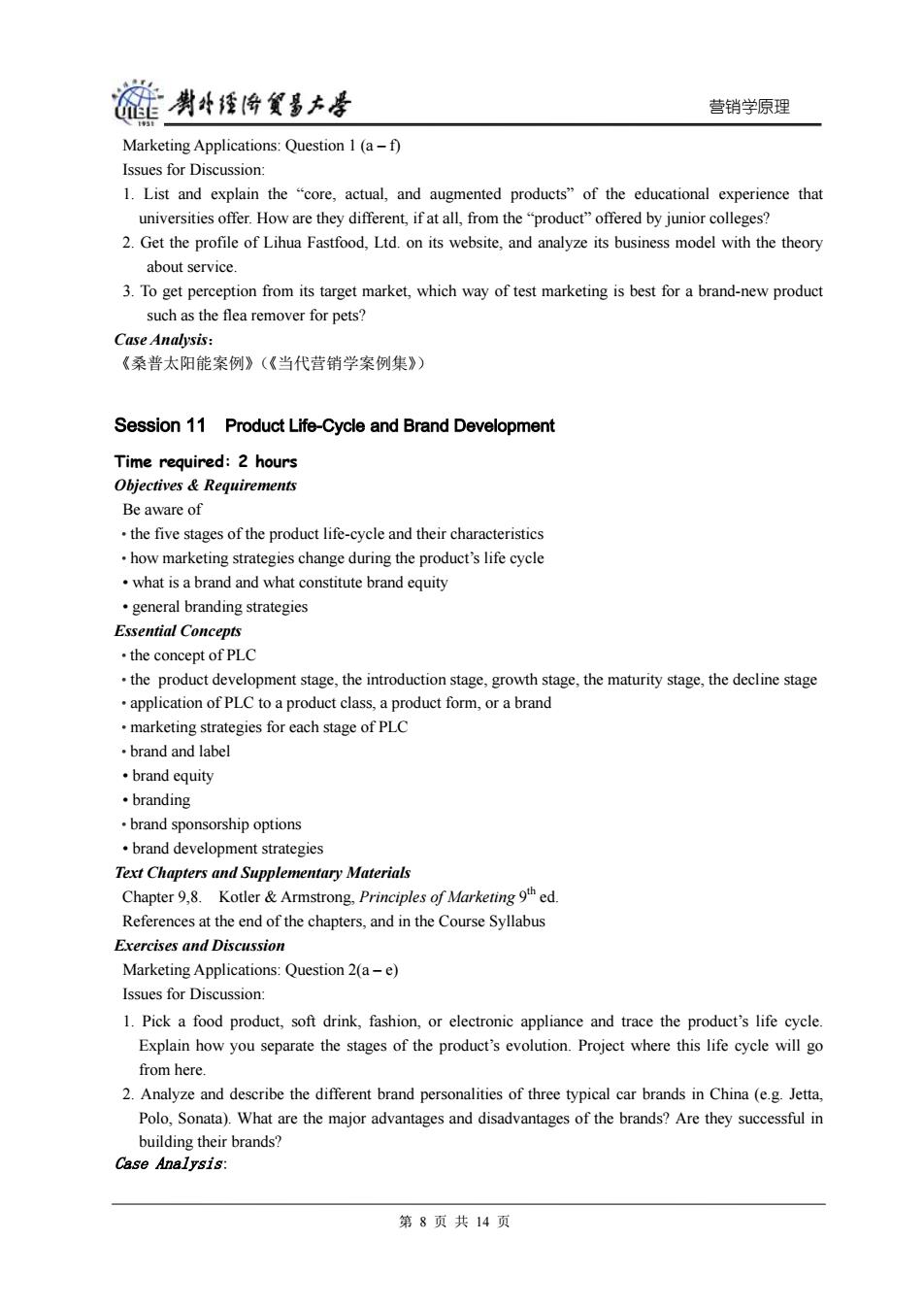
链勇4煙降餐多大学 营销学原理 Marketing Applications:Question 1 (a-f) Issues for Discussion: 1.List and explain the "core,actual,and augmented products"of the educational experience that universities offer.How are they different,if at all,from the "product"offered by junior colleges? 2.Get the profile of Lihua Fastfood,Ltd.on its website,and analyze its business model with the theory about service. 3.To get perception from its target market,which way of test marketing is best for a brand-new product such as the flea remover for pets? Case Analysis: 《桑普太阳能案例》(《当代营销学案例集》) Session 11 Product Life-Cycle and Brand Development Time required:2 hours Objectives Requirements Be aware of the five stages of the product life-cycle and their characteristics how marketing strategies change during the product's life cycle what is a brand and what constitute brand equity general branding strategies Essential Concepts ·the concept of PLC the product development stage,the introduction stage,growth stage,the maturity stage,the decline stage application of PLC to a product class,a product form,or a brand marketing strategies for each stage of PLC brand and label ·brand equity ·branding brand sponsorship options brand development strategies Text Chapters and Supplementary Materials Chapter 9,8.Kotler&Armstrong,Principles of Marketing 9thed. References at the end of the chapters,and in the Course Syllabus Exercises and Discussion Marketing Applications:Question 2(a-e) Issues for Discussion: 1.Pick a food product,soft drink,fashion,or electronic appliance and trace the product's life cycle. Explain how you separate the stages of the product's evolution.Project where this life cycle will go from here. 2.Analyze and describe the different brand personalities of three typical car brands in China(e.g.Jetta, Polo,Sonata).What are the major advantages and disadvantages of the brands?Are they successful in building their brands? Case Analysis: 第8页共14页
营销学原理 Marketing Applications: Question 1 (a – f) Issues for Discussion: 1. List and explain the “core, actual, and augmented products” of the educational experience that universities offer. How are they different, if at all, from the “product” offered by junior colleges? 2. Get the profile of Lihua Fastfood, Ltd. on its website, and analyze its business model with the theory about service. 3. To get perception from its target market, which way of test marketing is best for a brand-new product such as the flea remover for pets? Case Analysis: 《桑普太阳能案例》(《当代营销学案例集》) Session 11 Product Life-Cycle and Brand Development Time required: 2 hours Objectives & Requirements Be aware of • the five stages of the product life-cycle and their characteristics • how marketing strategies change during the product’s life cycle • what is a brand and what constitute brand equity • general branding strategies Essential Concepts • the concept of PLC • the product development stage, the introduction stage, growth stage, the maturity stage, the decline stage • application of PLC to a product class, a product form, or a brand • marketing strategies for each stage of PLC • brand and label • brand equity • branding • brand sponsorship options • brand development strategies Text Chapters and Supplementary Materials Chapter 9,8. Kotler & Armstrong, Principles of Marketing 9th ed. References at the end of the chapters, and in the Course Syllabus Exercises and Discussion Marketing Applications: Question 2(a – e) Issues for Discussion: 1. Pick a food product, soft drink, fashion, or electronic appliance and trace the product’s life cycle. Explain how you separate the stages of the product’s evolution. Project where this life cycle will go from here. 2. Analyze and describe the different brand personalities of three typical car brands in China (e.g. Jetta, Polo, Sonata). What are the major advantages and disadvantages of the brands? Are they successful in building their brands? Case Analysis: 第 8 页 共 14 页
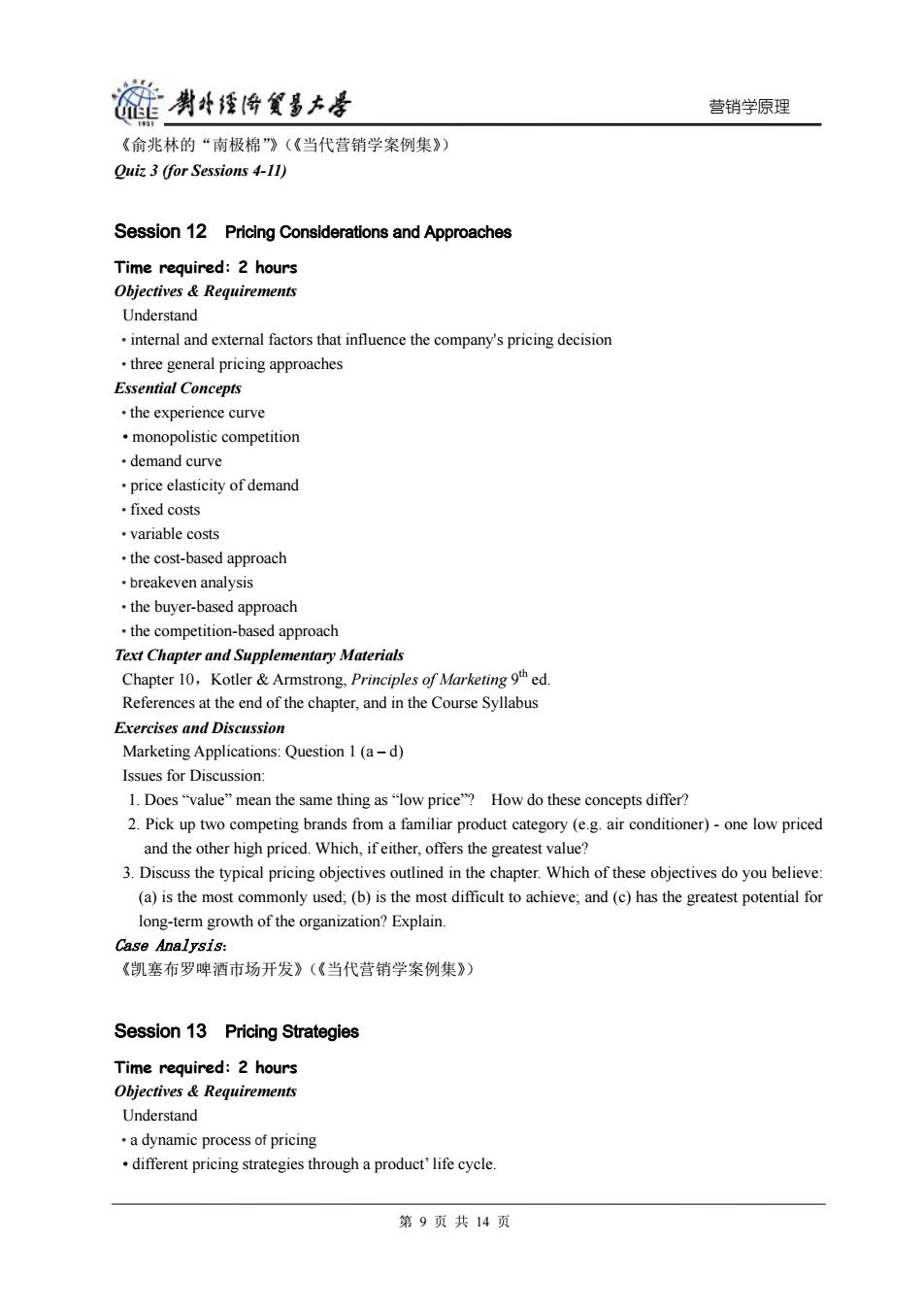
碰男华经海贸多大学 营销学原理 《俞兆林的“南极棉”》(《当代营销学案例集》) Ouiz 3 (for Sessions 4-11) Session 12 Pricing Considerations and Approaches Time required:2 hours Objectives Requirements Understand internal and external factors that influence the company's pricing decision three general pricing approaches Essential Concepts ·the experience curve monopolistic competition ·demand curve price elasticity of demand ·fixed costs variable costs the cost-based approach breakeven analysis .the buyer-based approach the competition-based approach Text Chapter and Supplementary Materials Chapter 10,Kotler&Armstrong,Principles of Marketing hed References at the end of the chapter,and in the Course Syllabus Exercises and Discussion Marketing Applications:Question 1 (a-d) Issues for Discussion: 1.Does"value"mean the same thing as"low price"?How do these concepts differ? 2.Pick up two competing brands from a familiar product category(e.g.air conditioner)-one low priced and the other high priced.Which,if either,offers the greatest value? 3.Discuss the typical pricing objectives outlined in the chapter.Which of these objectives do you believe: (a)is the most commonly used;(b)is the most difficult to achieve;and(c)has the greatest potential for long-term growth of the organization?Explain. Case Analysis: 《凯塞布罗啤酒市场开发》(《当代营销学案例集》) Session 13 Pricing Strategies Time required:2 hours Objectives Requirements Understand .a dynamic process of pricing different pricing strategies through a product'life cycle. 第9页共14页
营销学原理 《俞兆林的“南极棉”》(《当代营销学案例集》) Quiz 3 (for Sessions 4-11) Session 12 Pricing Considerations and Approaches Time required: 2 hours Objectives & Requirements Understand • internal and external factors that influence the company's pricing decision • three general pricing approaches Essential Concepts • the experience curve • monopolistic competition • demand curve • price elasticity of demand • fixed costs • variable costs • the cost-based approach • breakeven analysis • the buyer-based approach • the competition-based approach Text Chapter and Supplementary Materials Chapter 10,Kotler & Armstrong, Principles of Marketing 9th ed. References at the end of the chapter, and in the Course Syllabus Exercises and Discussion Marketing Applications: Question 1 (a – d) Issues for Discussion: 1. Does “value” mean the same thing as “low price”? How do these concepts differ? 2. Pick up two competing brands from a familiar product category (e.g. air conditioner) - one low priced and the other high priced. Which, if either, offers the greatest value? 3. Discuss the typical pricing objectives outlined in the chapter. Which of these objectives do you believe: (a) is the most commonly used; (b) is the most difficult to achieve; and (c) has the greatest potential for long-term growth of the organization? Explain. Case Analysis: 《凯塞布罗啤酒市场开发》(《当代营销学案例集》) Session 13 Pricing Strategies Time required: 2 hours Objectives & Requirements Understand • a dynamic process of pricing • different pricing strategies through a product’ life cycle. 第 9 页 共 14 页

链勇4经降餐多大孝 营销学原理 how to assess/respond to competitors'price change Essential Concepts .skimming pricing vs.penetration pricing product mix pricing strategies(product line pricing,captive-product pricing,etc.) adjustment strategies initiating price changes ways to assess/respond to competitor's price changes Text Chapter and Supplementary Materials Chapter 11,Appendix 2,Kotler&Armstrong,Principles of Marketing 9th ed. References at the end of the chapter,and in the Course Syllabus Exercises and Discussion Marketing Applications:Question 2(a-c) Issues for Discussion: 1.What do you think about the price war of air-conditioner with approaching of the hot summer?Is it reasonable? 2.Do you agree that pricing is the most effective tool of competition in this industry? 3.Can you imagine any disadvantages of such kind of price war? Case Analysis: "Circuit City:Selling Used Cars like Stereos",Principles of Marketing 9hed. Ouiz 4 (for Sessions 12-13) Session 14 Distribution Channel Designing and Management Time required:2 hours Objectives Requirements Be aware of .roles of distribution channels the channel design process management of channel system Essential Concepts the roles of distribution channel Product Complexity Grid marketing channel functions flows in distribution channels Vertical Marketing System(VMS alternatives of channel width Text Chapter and Supplementary Materials Chapter 12,Kotler Armstrong,Principles of Marketing 9 ed. References at the end of the chapter,and in the Course Syllabus Exercises and Discussion Marketing Applications:Question 1 (a-d) Issues for Discussion: L.What happened between Gome(国美)and Gree(格力)? 第10页共14页
营销学原理 • how to assess/respond to competitors' price change Essential Concepts • skimming pricing vs. penetration pricing • product mix pricing strategies (product line pricing, captive-product pricing, etc.) • adjustment strategies • initiating price changes • ways to assess/respond to competitor’s price changes Text Chapter and Supplementary Materials Chapter 11,Appendix 2, Kotler & Armstrong, Principles of Marketing 9th ed. References at the end of the chapter, and in the Course Syllabus Exercises and Discussion Marketing Applications: Question 2 (a – c) Issues for Discussion: 1. What do you think about the price war of air-conditioner with approaching of the hot summer? Is it reasonable? 2. Do you agree that pricing is the most effective tool of competition in this industry? 3. Can you imagine any disadvantages of such kind of price war? Case Analysis: “Circuit City : Selling Used Cars like Stereos”, Principles of Marketing 9th ed. Quiz 4 (for Sessions 12-13) Session 14 Distribution Channel Designing and Management Time required: 2 hours Objectives & Requirements Be aware of • roles of distribution channels • the channel design process • management of channel system Essential Concepts • the roles of distribution channel • Product Complexity Grid • marketing channel functions • flows in distribution channels • Vertical Marketing System( VMS ) • alternatives of channel width Text Chapter and Supplementary Materials Chapter 12,Kotler & Armstrong, Principles of Marketing 9th ed. References at the end of the chapter, and in the Course Syllabus Exercises and Discussion Marketing Applications: Question 1 (a – d) Issues for Discussion: 1. What happened between Gome (国美) and Gree (格力)? 第 10 页 共 14 页